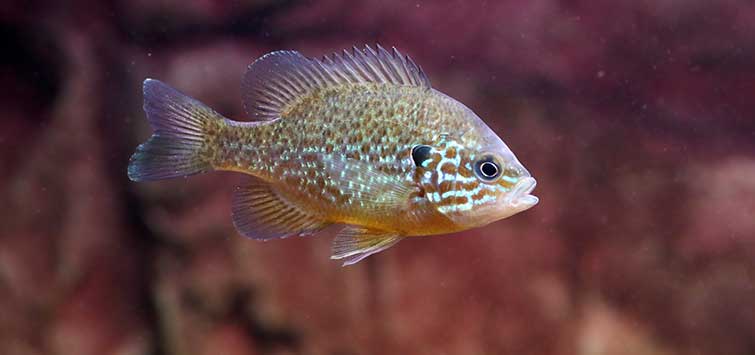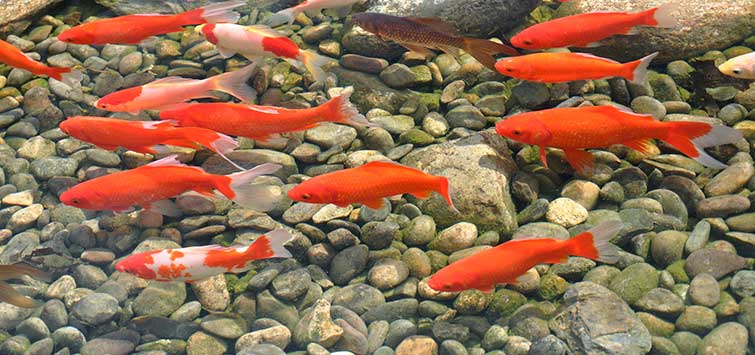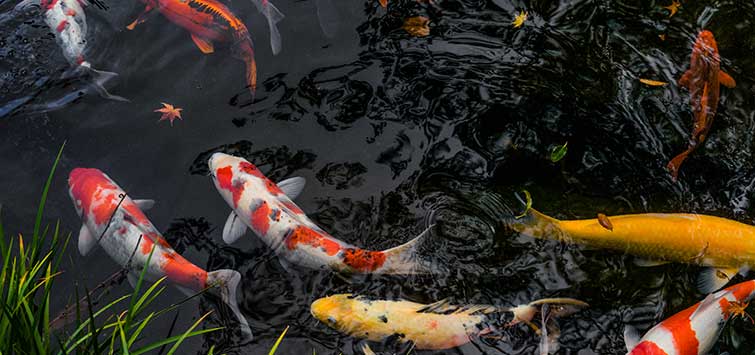Alternatives for the Home or Garden: The Centrarchids of North America, Part 1
Author: Stan Sung
For many hobbyists, warmer weather means it is time to enjoy fishkeeping in the great outdoors. In part one of his look at North American centrarchids, our world traveler comes back to the states to describe some wonderful native alternatives to koi and goldfish for an outdoor pond.
Spring Beginnings
Freed from the grips of winter, we enjoy new greenery and bright, longer days. Nature has thawed, and our native fish begin to color up and breed. Although often overlooked, these North American species are alternatives the aquarium or pond hobbyist may want to consider.
A Slice of the Great Frontier
I am frequently asked why I am so enthusiastic about keeping native American sunfish and bass in my aquariums. One obvious reason is their shimmering, good looks. Another is that they remind me of the lakes and swamps I love to explore. Gazing at my tank full of glittering pumpkinseeds Lepomis gibbosustakes me back to my youth when I fished in sun-dappled ponds while visiting my uncle in New Jersey on summer break. Less colorful species, such as the mud sunfish, possess heaps of attitude and curiosity. These remind me of the mysterious swamps of the Deep South. Whether native fish are collected in the spring and may be bred after a natural overwintering period, or they are placed in ponds and exposed to the seasons, they are excellent choices for homes and gardens.
I have collected tropical fish extensively throughout many parts of the world, but few areas provide me with the same level of excitement as diving into a crystalline stream in Alabama to watch the gloriously colored darters and shiners spawn. Sometimes a large long-ear sunfish Lepomis megalotis may appear, resembling a sparkling blue fire under the hot afternoon sun. I have always been interested in cichlids, and no other fish is as comparable to them in looks and behaviors as sunfish. So this month I’d like to introduce you to the fantastic world of North American centrarchids.
Treat Your Fish Responsibly
Any article on native fish should first include a few rules that the hobbyist should never ignore. Please make sure that the fishes collected are legal to capture and are not endangered or protected. Some fish, particularly the larger species presented here, are considered game fish and are not allowed to be collected with nets. These large species should only be collected from private properties with the landowner’s consent. Don’t ever take more than you can adequately house. Most importantly, please never, ever release unwanted pets back into nature. The introduction of exotic or native species can be catastrophic to local wetlands, and in many places it is illegal.
Basics of Centrarchids
Fishes in the family Centrarchidae are mostly deep-bodied fishes that breed in sand depressions. There are under 10 genera and about 30 species. These include the basses Micropterus, crappies Pomoxis, fliers Centrarchus, primitive sunfish Archoplites, swamp-dwelling sunfish of the genus Acantharchus, rock bass Ambloplites, the standard sunfish Lepomis, and finally the dwarf sunfish belonging to the Enneacanthus complex. Within these diverse groups are species ranging from the very large (some would say monstrous) sportfish only suitable for public aquariums and large garden ponds/small lakes, to the tiny, jewel-like fishes for the richly planted hobbyist tank.
Breeding
Males of all species vigorously defend a chosen territory in which they will dig out a saucer-shaped nest in the substrate. During the breeding season, males will try to attract females with body-wagging and tail-flapping motions. Once spawning has been completed, the female is driven off and the male will be the sole caretaker of the eggs and fry until at least the free-swimming stage. Many sunfish are colonial breeders in which males of multiple species sometimes select breeding sites within close proximity to one another.
Basics of the Genus Lepomis
Pumpkinseed Sunfish (Lepomis gibbosus)
The beloved pumpkinseed is a fish of the cool, clear waters of the Northeast. This sunfish is generally associated with thick aquatic vegetation and lily beds. Pumpkinseeds are often the first centrarchid aquarists are introduced to. Crimson spots and turquoise spangles and striations adorn these shimmering fish.
Dominant males are quite boisterous and are not beyond choosing the most desirable spot in the aquarium (usually front and center, where the food is dropped in) and energetically defending their territory. In suitably spacious accommodations, there will be plenty of flared gills and tail wagging without serious damage to the subordinate fish. In a smaller aquarium, this species can overwhelm its tankmates. There are records of pumpkinseeds attaining lengths of up to 16 inches, but individuals of half this size are more common.
These durable subjects will consume all prepared foods, with frozen bloodworms, mysis, and chopped krill being their favorites. Keep your pumpkinseeds in a cool area of the house or garden. They will benefit from a wintering period in which the water is allowed to cool down and food is sparingly offered. Gradually increase the temperature and amount of food offered, and your pumpkinseeds will be a blaze of color and may even spawn for you.
Long-Ear Sunfish (Lepomis megalotis)
Long-ears are brilliantly colored and highly variable sunfish that must rank as one of the most beautiful of all the centrarchids. This is usually a warm-water, stream-dwelling species from the central and southern portions of the United States. The most distinguishable feature on these beauties is the large, black earflap that is especially well developed in mature males—megalotis actually means big ear. Because of their wide geographical range, there are many regional variations. Their base body coloration can be anything from olive green to tan, yellow, orange, or red, with usually heavy iridescent blue spangling. Some of the most beautiful varieties from the central part of their range are robust, fiery orange fish with peacock-blue spangles.
This is also an aggressive species of sunfish that should be able to coexist with others of a similar disposition, such as Lepomis gibbosus, L. macrochirus, and L. punctatus. Long-ears are not fussy regarding food, and all carnivorous fare is taken. Keep these 9-inch fish in a spacious aquarium that is highly oxygenated and well filtered. Due to their amazing coloration, this is one of the most popular species kept by sunfish enthusiasts. Some hobbyists specialize in megalotis and maintain separate populations of these fish, as each location offers a fantastically different but highly beautiful variation. This is one of the few North American sunfish that is raised in Southeast Asia for the aquarium trade.
Dollar Sunfish (Lepomis marginatus)
In many ways this fish can be described as a miniature version of Lepomis megalotis. The dollar sunfish makes its home primarily in the swamps of the Southern United States. Dollars are tall-bodied and extremely colorful. Their usual coloration is a warm brown or orange with wintergreen spangles and seemingly electrically charged fins of the same mint-green colors. Despite a modest adult size of less than 5 inches, this is a fierce species that spends a great deal of time and energy fighting. Males continually antagonize each other with flared gills and dropped ventral fins (which is a standard aggression stance in sunfish). Their preferred habitats are usually sluggish, tannin-stained, and vegetation-choked backwaters. Blackwater extract or water filtered through peat is usually beneficial in maintaining dollars in peak condition and color. Because of its scrappy nature, Lepomis marginatus is best suited for a species-only tank.
Red-Ear Sunfish (Lepomis microlophus)
The red-ear sunfish is a jumbo fish that can easily attain a length of over one foot. This species, the pumpkinseed Lepomis gibbosus, and the bluegill Lepomis macrochirus are the only sunfish with large, pointed pectoral fins. Considering the grand size of adult specimens, L. microlophus remains a rather benign aquarium resident. Smaller specimens adapt well to captive conditions. It is not advisable to place these easily overwhelmed sunfish in aquariums containing more boisterous and outgoing centrarchids. In parts of their native range, red-ears are called shellcrackers, as they possess extensive molar surfaces on their pharyngeal arches and the musculature to allow them to crack mollusk shells. In aquariums, red-ears (especially newly captured specimens) can be a little picky about their diet. These gentle fish prefer to feed off the bottom of the aquarium. Frozen bloodworms are a favored food for shellcrackers and all other sunfish.
Bluegill Sunfish (Lepomis macrochirus)
Of all the Lepomis species, the bluegill is probably the least desirable for the home aquarium. This is a large-growing (around 14 inches TL) and aggressive species that can easily take over a small pond or large aquarium. Although some large males do develop beautiful coloration and a substantial notch on their nape, these specimens are invariably antagonistic. Smaller individuals have a noticeable black spot on the anterior portion of the soft dorsal fin.
Warmouth (Lepomis gulosus)
This is a predatory sunfish that attains a length of around 8 inches. Warmouths are denizens of leaf-litter substrates where their cryptic, mottled pattern keeps them well camouflaged. During breeding, specimens develop bright yellow coloration and startling, scarlet-colored eyes. Although they’re not terribly bossy in the aquarium, only keep warmouths in with fish too large to swallow. Aggression is usually limited to feeding time. Large chunks of carnivorous offerings should be fed to warmouths.
Orange-Spotted Sunfish (Lepomis humilis)
This species is one of the aquatic gems of North America. The name humilis suggests a species that is low or humble, so the species name may be in reference to the small 4-inch stature of the orange-spotted sunfish. But there is absolutely nothing lowly or humble about the coloration of adult male Lepomis humilis. Fiery orange spots jump out from the iridescent, sky-blue body. All of the fins are bright orange, and the red eye is a crowning touch to an already spectacular fish.
Because of their small size, it is not advisable to place orange-spots in with the larger Lepomis species, but they get along swimmingly with large shiners and suckers. Keep in mind, though, that they possess surprisingly large mouths and will eat any tankmates small enough to be consumed.
Orange-spots are also greedy, gluttonous feeders, so restraint must be used when feeding them. I have noticed that they will immediately bloat if fed too much of their favorite foods (frozen bloodworms) and will quickly perish due to gorging. I try to limit the frozen bloodworms to no more than ¹⁄³ of their diet. Other foods offered are frozen brine shrimp and spirulina-based, frozen formula diets. This species is found in basic-water streams flowing through prairies, so hard, basic water should be provided.
Red-Breast Sunfish (Lepomis auratus)
Another jaw-dropping, gloriously colored species of sunfish, L. auritus is variable within its extensive range. All populations possess a jet-black, highly elongated earflap. Red-breasts grow to around 8 inches in length. These fish make greedy captives that may become obese and unattractive if fed too much. The adult males are a kaleidoscope of red, orange, and blue-green colors. I would consider L. auritus to be less belligerent than many of the large Lepomis species. Keep a close eye on red-breast sunfish to ensure that they do not get overly harassed in a community of large sunfish.
Green Sunfish (Lepomis cyanellus)
Here is a robust, bass-like species of sunfish that attains more then 8 inches in length. In spacious accommodations, green sunfish will coexist with bluegills and pumpkinseeds. I would place their temperaments on par with those other two aggressive species. These fish are incredibly hardy and are not particular about water conditions or foods accepted. Their hard fins are bordered by a beautiful white, yellow, or orange coloration, which contrasts nicely with their dark olive or brownish bodies.
Red-Spotted Sunfish (Lepomis miniatus)
Male L. miniatus develop lovely scarlet-edged scales along their flanks. Although the full size of this species lies somewhere around 8 inches, smaller individuals may already show this attractive coloration. As in many of the Lepomis species, young adults may be more attractive in coloration than full-sized, very mature fish.
This sunfish prefers heavily vegetated areas that lack current in nature. Pulling a dipnet through leaf litter usually yields results. Red-spots are hardy and can be feisty in the home aquarium.
Spotted Sunfish (Lepomis punctatus)
Lepomis miniatus and L. punctatus intergrade in both the upper Coosa River drainage in Georgia and the coastal drainages from the Perdido River eastward. At one time, both species were considered to be L. punctatus. The intergraded populations have coloration that represents both spotted and red-spotted sunfish. The spots along their sides are dark, reddish brown.
Spotted sunfish can also be found in the slack water areas and muddy, debris-saturated bogs. Aquarium care and behavior are the same for both species.
Bantam Sunfish (Lepomis symmetricus)
This is the smallest Lepomis species, topping out at under 4 inches. This is a stocky, exceedingly peaceful species that thrives in planted, tannin-stained aquariums. Like orange-spotted sunfish, the bantam sunfish can overindulge on high-protein foods and succumb after gorging on too much food. Feed frozen bloodworms sparingly. Breeding males are handsome and feature a suit of jet-black, gold highlights, and red eyes.
[Part 2 will cover centrarchids from other genera, including basses and crappies—Eds.]
See the full article on TFH Digital http://www.tfhdigital.com/tfh/200904/#pg95

.png?h=595&iar=0&w=2781&hash=5FD5E69473BCC22199FBFA2FB71B6033)



